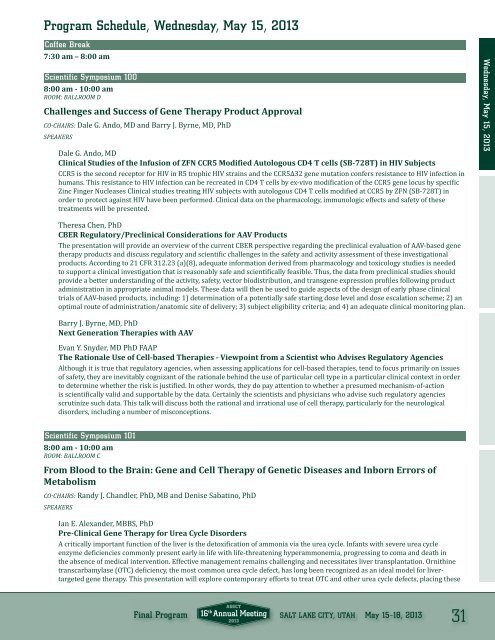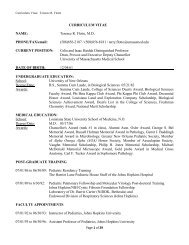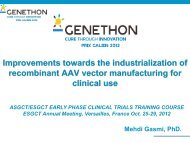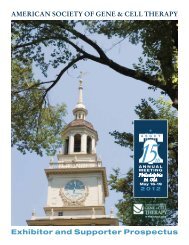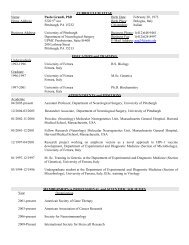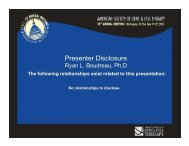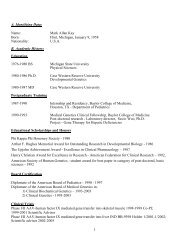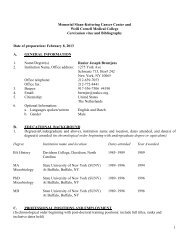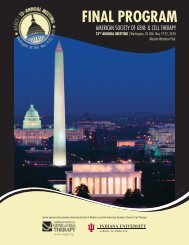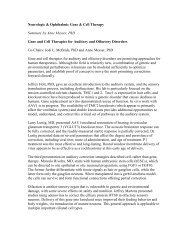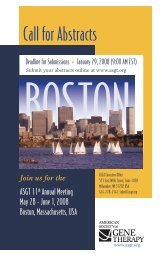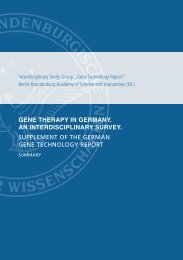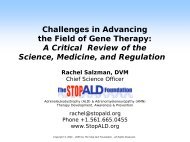Final Program - American Society of Gene & Cell Therapy
Final Program - American Society of Gene & Cell Therapy
Final Program - American Society of Gene & Cell Therapy
Create successful ePaper yourself
Turn your PDF publications into a flip-book with our unique Google optimized e-Paper software.
<strong>Program</strong> Schedule, Wednesday, May 15, 2013<br />
C<strong>of</strong>fee Break<br />
7:30 am – 8:00 am<br />
Scientific Symposium 100<br />
8:00 am - 10:00 am<br />
ROOM: BALLROOM D<br />
Challenges and Success <strong>of</strong> <strong>Gene</strong> <strong>Therapy</strong> Product Approval<br />
CO-CHAIRS: Dale G. Ando, MD and Barry J. Byrne, MD, PhD<br />
SPEAKERS<br />
Dale G. Ando, MD<br />
Clinical Studies <strong>of</strong> the Infusion <strong>of</strong> ZFN CCR5 Modiied Autologous CD4 T cells (SB-728T) in HIV Subjects<br />
CCR5 is the second receptor for HIV in R5 trophic HIV strains and the CCR5Δ32 gene mutation confers resistance to HIV infection in<br />
humans. This resistance to HIV infection can be recreated in CD4 T cells by ex-vivo modiication <strong>of</strong> the CCR5 gene locus by speciic<br />
Zinc Finger Nucleases Clinical studies treating HIV subjects with autologous CD4 T cells modiied at CCR5 by ZFN (SB-728T) in<br />
order to protect against HIV have been performed. Clinical data on the pharmacology, immunologic effects and safety <strong>of</strong> these<br />
treatments will be presented.<br />
Wednesday, May 15, 2013<br />
Theresa Chen, PhD<br />
CBER Regulatory/Preclinical Considerations for AAV Products<br />
The presentation will provide an overview <strong>of</strong> the current CBER perspective regarding the preclinical evaluation <strong>of</strong> AAV-based gene<br />
therapy products and discuss regulatory and scientiic challenges in the safety and activity assessment <strong>of</strong> these investigational<br />
products. According to 21 CFR 312.23 (a)(8), adequate information derived from pharmacology and toxicology studies is needed<br />
to support a clinical investigation that is reasonably safe and scientiically feasible. Thus, the data from preclinical studies should<br />
provide a better understanding <strong>of</strong> the activity, safety, vector biodistribution, and transgene expression proiles following product<br />
administration in appropriate animal models. These data will then be used to guide aspects <strong>of</strong> the design <strong>of</strong> early phase clinical<br />
trials <strong>of</strong> AAV-based products, including: 1) determination <strong>of</strong> a potentially safe starting dose level and dose escalation scheme; 2) an<br />
optimal route <strong>of</strong> administration/anatomic site <strong>of</strong> delivery; 3) subject eligibility criteria; and 4) an adequate clinical monitoring plan.<br />
Barry J. Byrne, MD, PhD<br />
Next <strong>Gene</strong>ration Therapies with AAV<br />
Evan Y. Snyder, MD PhD FAAP<br />
The Rationale Use <strong>of</strong> <strong>Cell</strong>-based Therapies - Viewpoint from a Scientist who Advises Regulatory Agencies<br />
Although it is true that regulatory agencies, when assessing applications for cell-based therapies, tend to focus primarily on issues<br />
<strong>of</strong> safety, they are inevitably cognizant <strong>of</strong> the rationale behind the use <strong>of</strong> particular cell type in a particular clinical context in order<br />
to determine whether the risk is justiied. In other words, they do pay attention to whether a presumed mechanism-<strong>of</strong>-action<br />
is scientiically valid and supportable by the data. Certainly the scientists and physicians who advise such regulatory agencies<br />
scrutinize such data. This talk will discuss both the rational and irrational use <strong>of</strong> cell therapy, particularly for the neurological<br />
disorders, including a number <strong>of</strong> misconceptions.<br />
Scientific Symposium 101<br />
8:00 am - 10:00 am<br />
ROOM: BALLROOM C<br />
From Blood to the Brain: <strong>Gene</strong> and <strong>Cell</strong> <strong>Therapy</strong> <strong>of</strong> <strong>Gene</strong>tic Diseases and Inborn Errors <strong>of</strong><br />
Metabolism<br />
CO-CHAIRS: Randy J. Chandler, PhD, MB and Denise Sabatino, PhD<br />
SPEAKERS<br />
Ian E. Alexander, MBBS, PhD<br />
Pre-Clinical <strong>Gene</strong> <strong>Therapy</strong> for Urea Cycle Disorders<br />
A critically important function <strong>of</strong> the liver is the detoxiication <strong>of</strong> ammonia via the urea cycle. Infants with severe urea cycle<br />
enzyme deiciencies commonly present early in life with life-threatening hyperammonemia, progressing to coma and death in<br />
the absence <strong>of</strong> medical intervention. Effective management remains challenging and necessitates liver transplantation. Ornithine<br />
transcarbamylase (OTC) deiciency, the most common urea cycle defect, has long been recognized as an ideal model for livertargeted<br />
gene therapy. This presentation will explore contemporary efforts to treat OTC and other urea cycle defects, placing these<br />
<strong>Final</strong> <strong>Program</strong> SALT LAKE CITY, UTAH May 15–18, 2013<br />
31


